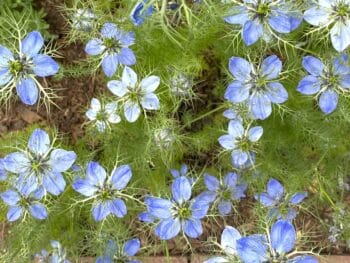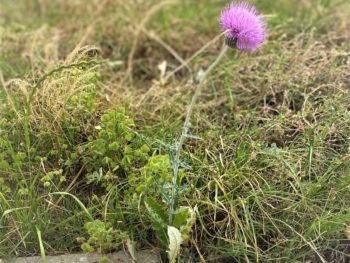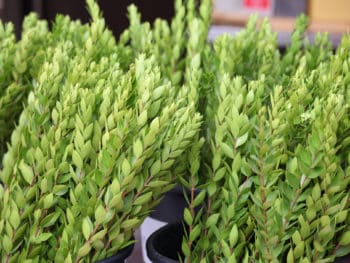Blooming coriander in my garden this week inspired me to add a letter to the A-to-Z Primer of Plants from God’s Word, U for umbellifers. These humble vegetables, herbs, and spices from the Umbelliferae family plod along without much fuss or fanfare while filling a garden-to-table life.
Until they bloom, that is! Umbels flower spectacularly—in fireworks-like patterns, ultra-brilliant shows of diminutive, dotted blossoms arranged in larger radial arrays to dazzle your garden as weather warms up. Additionally, umbellifers provide much forage to pollinators (see more about pollinator gardens).
Umbels in the Bible
Just three umbels play small, unassuming parts in Scripture, yet bringing these individuals together as one makes their presence more intriguing. Dig in to this hearty collection of plants, and may every detail in the Word of God delight you!
Take hold of my words with all of your heart.
Proverbs 4:4 NIV
Draw your cursor over the poem to reveal links to Scripture
 is for umbellifers,
is for umbellifers,
a family of flavorsome plants
scattered humbly in few Bible verses,
nonetheless grounding God’s Word in the land.
Particular details, the umbels embellish
like the color, the care, or the purpose—
amplifying the Lord’s instruction,
testing people to trust His promise.
The family is diverse in its offering,
yielding tasty leaves, seeds, stalks, or roots.
Parsley, anise, celery, carrots, and parsnips
is the spread of their non-Bible produce.
Yet umbels are united by their flowers’
structure, appearance, and luster;
5 petals, 5 sepals, 5 stamens, precisely
patterned in radial clusters.
Airy, white or golden, pin-pointed tufts—
individual, petite flowers are spun
into a larger, eye-catching array of flourish,
enticing pollinators as one.
In fact, some call the family Apiaceae,
suggesting their attraction to bees.
Either Apiaceae or Umbelliferae is accepted,
depending on which botanist to please.
It is worth noting the poisonous family member, hemlock;
perhaps the “ro’sh” of Amos and Hosea.
Keep umbel flowers vase-only on the table,
eating them NOT a good idea.
 Back to God’s Word, and the display of manna
Back to God’s Word, and the display of manna
a desert miracle the Israelites discovered.
Coriander compared to this heavenly bread,
its seeds of similar color.
 Dill, another umbellifer, was an example
Dill, another umbellifer, was an example
Jesus used to scold the care of church leaders:
Don’t be smug about rule-following
if mercy is not your procedure.
 Cumin, the most prominent umbel,
Cumin, the most prominent umbel,
a savory seed flavor well-known,
joined dill in Jesus’ discipline
and carried a message partly its own.
Paired with nigella*, cumin seeds were included
in showing the Lord’s intimate knowledge.
Listen! And pay attention! As
his instruction to us is flawless.
As specific as the plowing, sowing, and threshing
that various crops require,
the LORD knows all methods, the right way to harvest,
and blessing is His desire.
Put together justice, mercy, and faithfulness,
arranged by magnificent wisdom;
then test hearts to follow instruction.
The results? Everything we need to please Him.
May God, who puts all things together, makes all things whole, Who made a lasting mark through the sacrifice of Jesus, the sacrifice of blood that sealed the eternal covenant,
Who led Jesus, our Great Shepherd, up and alive from the dead,
Now put you together, provide you with everything you need to please him,
Make us into what gives him most pleasure, by means of the sacrifice of Jesus, the Messiah.
All glory to Jesus forever and always!
Hebrews 13:20-21 The Message
*Nigella, Nigella sativa, has been historically translated “fitches,” “caraway,” “dill,” and “black cumin.” See more about growing and cooking with nigella in our Plant Guide.
See God’s Word for Gardeners Bible for more devotions on cumin, “He Knows,” from the theme of Intimacy with God in the Garden in the Garden Stories section near Isaiah 28. Find dill and cumin in “A Gardener’s Clue,” from the Bearing Fruit theme in the Garden Work section near Matthew 23:23
For more on growing and cooking with Coriander, Dill and Cumin see our Plant Guide
Photo Credits: ©2016-2017 Shelley S. Cramm
Dill photo was recently published in The Dallas Morning News, “Grow Your Faith and Your Garden with These Biblical Herbs,” April 12, 2017
















